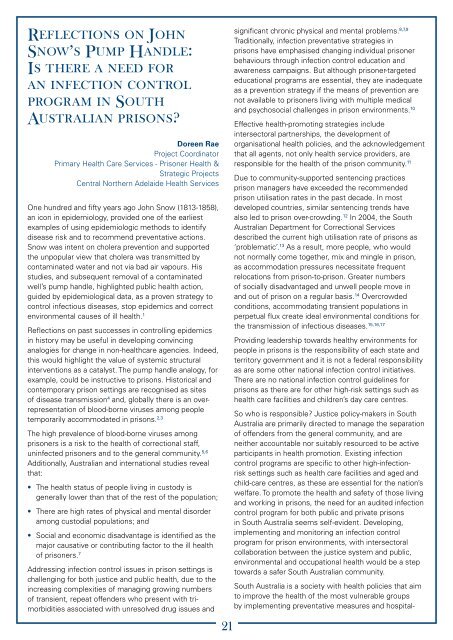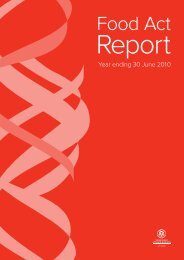Public Health and Communicable Diseases - SA Health - SA.Gov.au
Public Health and Communicable Diseases - SA Health - SA.Gov.au
Public Health and Communicable Diseases - SA Health - SA.Gov.au
You also want an ePaper? Increase the reach of your titles
YUMPU automatically turns print PDFs into web optimized ePapers that Google loves.
Reflections on JohnSnow’s Pump H<strong>and</strong>le:Is there a need foran infection controlprogram in SouthAustralian prisons?Doreen RaeProject CoordinatorPrimary <strong>Health</strong> Care Services - Prisoner <strong>Health</strong> &Strategic ProjectsCentral Northern Adelaide <strong>Health</strong> ServicesOne hundred <strong>and</strong> fifty years ago John Snow (1813-1858),an icon in epidemiology, provided one of the earliestexamples of using epidemiologic methods to identifydisease risk <strong>and</strong> to recommend preventative actions.Snow was intent on cholera prevention <strong>and</strong> supportedthe unpopular view that cholera was transmitted bycontaminated water <strong>and</strong> not via bad air vapours. Hisstudies, <strong>and</strong> subsequent removal of a contaminatedwell’s pump h<strong>and</strong>le, highlighted public health action,guided by epidemiological data, as a proven strategy tocontrol infectious diseases, stop epidemics <strong>and</strong> correctenvironmental c<strong>au</strong>ses of ill health. 1Reflections on past successes in controlling epidemicsin history may be useful in developing convincinganalogies for change in non-healthcare agencies. Indeed,this would highlight the value of systemic structuralinterventions as a catalyst. The pump h<strong>and</strong>le analogy, forexample, could be instructive to prisons. Historical <strong>and</strong>contemporary prison settings are recognised as sitesof disease transmission 4 <strong>and</strong>, globally there is an overrepresentationof blood-borne viruses among peopletemporarily accommodated in prisons. 2,3The high prevalence of blood-borne viruses amongprisoners is a risk to the health of correctional staff,uninfected prisoners <strong>and</strong> to the general community. 5,6Additionally, Australian <strong>and</strong> international studies revealthat:• The health status of people living in custody isgenerally lower than that of the rest of the population;• There are high rates of physical <strong>and</strong> mental disorderamong custodial populations; <strong>and</strong>• Social <strong>and</strong> economic disadvantage is identified as themajor c<strong>au</strong>sative or contributing factor to the ill healthof prisoners. 7Addressing infection control issues in prison settings ischallenging for both justice <strong>and</strong> public health, due to theincreasing complexities of managing growing numbersof transient, repeat offenders who present with trimorbiditiesassociated with unresolved drug issues <strong>and</strong>21significant chronic physical <strong>and</strong> mental problems. 8,7,9Traditionally, infection preventative strategies inprisons have emphasised changing individual prisonerbehaviours through infection control education <strong>and</strong>awareness campaigns. But although prisoner-targetededucational programs are essential, they are inadequateas a prevention strategy if the means of prevention arenot available to prisoners living with multiple medical<strong>and</strong> psychosocial challenges in prison environments. 10Effective health-promoting strategies includeintersectoral partnerships, the development oforganisational health policies, <strong>and</strong> the acknowledgementthat all agents, not only health service providers, areresponsible for the health of the prison community. 11Due to community-supported sentencing practicesprison managers have exceeded the recommendedprison utilisation rates in the past decade. In mostdeveloped countries, similar sentencing trends havealso led to prison over-crowding. 12 In 2004, the SouthAustralian Department for Correctional Servicesdescribed the current high utilisation rate of prisons as‘problematic’. 13 As a result, more people, who wouldnot normally come together, mix <strong>and</strong> mingle in prison,as accommodation pressures necessitate frequentrelocations from prison-to-prison. Greater numbersof socially disadvantaged <strong>and</strong> unwell people move in<strong>and</strong> out of prison on a regular basis. 14 Overcrowdedconditions, accommodating transient populations inperpetual flux create ideal environmental conditions forthe transmission of infectious diseases. 15,16,17Providing leadership towards healthy environments forpeople in prisons is the responsibility of each state <strong>and</strong>territory government <strong>and</strong> it is not a federal responsibilityas are some other national infection control initiatives.There are no national infection control guidelines forprisons as there are for other high-risk settings such ashealth care facilities <strong>and</strong> children’s day care centres.So who is responsible? Justice policy-makers in SouthAustralia are primarily directed to manage the separationof offenders from the general community, <strong>and</strong> areneither accountable nor suitably resourced to be activeparticipants in health promotion. Existing infectioncontrol programs are specific to other high-infectionrisksettings such as health care facilities <strong>and</strong> aged <strong>and</strong>child-care centres, as these are essential for the nation’swelfare. To promote the health <strong>and</strong> safety of those living<strong>and</strong> working in prisons, the need for an <strong>au</strong>dited infectioncontrol program for both public <strong>and</strong> private prisonsin South Australia seems self-evident. Developing,implementing <strong>and</strong> monitoring an infection controlprogram for prison environments, with intersectoralcollaboration between the justice system <strong>and</strong> public,environmental <strong>and</strong> occupational health would be a steptowards a safer South Australian community.South Australia is a society with health policies that aimto improve the health of the most vulnerable groupsby implementing preventative measures <strong>and</strong> hospital-
















